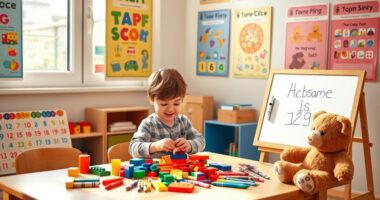Social and emotional development is essential for building resilience in children. When you nurture supportive relationships and teach emotional regulation, you help them bounce back from setbacks. Skills like self-awareness and problem-solving empower kids to face challenges with confidence. By creating positive environments at home and school, you can foster adaptability and a growth mindset. Understanding these concepts will help you cultivate resilience in children, leading to more effective strategies for their emotional well-being. Discover more insights on this topic.
Key Takeaways
- Resilience is fostered through supportive relationships and mastery opportunities, helping children adapt positively to adversity.
- Social-Emotional Learning (SEL) enhances self-awareness and emotional regulation, crucial for building resilience in children.
- Encouraging a growth mindset and problem-solving skills empowers children to overcome setbacks and challenges.
- Mindfulness practices and emotional expression promote acceptance of feelings, aiding stress management and resilience.
- Family and community involvement in SEL initiatives strengthens support systems for vulnerable populations, enhancing resilience.
Understanding Resilience in Early Childhood
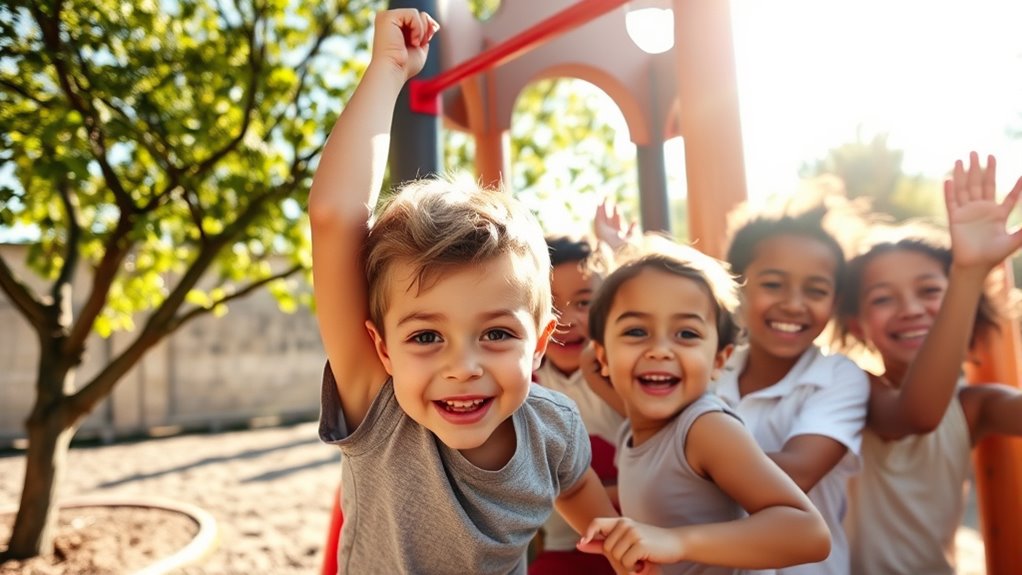
Understanding resilience in early childhood is essential because it lays the foundation for how children cope with challenges later in life. Resilience involves resources and processes that help kids adapt positively in the face of adversity.
By fostering supportive relationships and offering opportunities for mastery, you can help children build their resilience. This early development is critical; resilient kids are less likely to experience anxiety or depression and tend to engage more socially. Additionally, building passion and motivation can serve as a key component in nurturing resilience, as it encourages children to pursue their interests even in the face of setbacks.
Fostering supportive relationships and mastery opportunities is vital for building resilience in children, promoting their social engagement and emotional well-being.
Community support also plays an important role in facilitating resilience. Strong caregiver-child relationships, adequate stimulation, and good nutrition contribute considerably to healthy brain development, enabling children to manage emotions and challenges effectively. Additionally, seeking support from friends and family can significantly enhance a child’s ability to bounce back from setbacks.
With these elements in place, you’re setting the stage for a resilient future.
The Role of Social-Emotional Learning
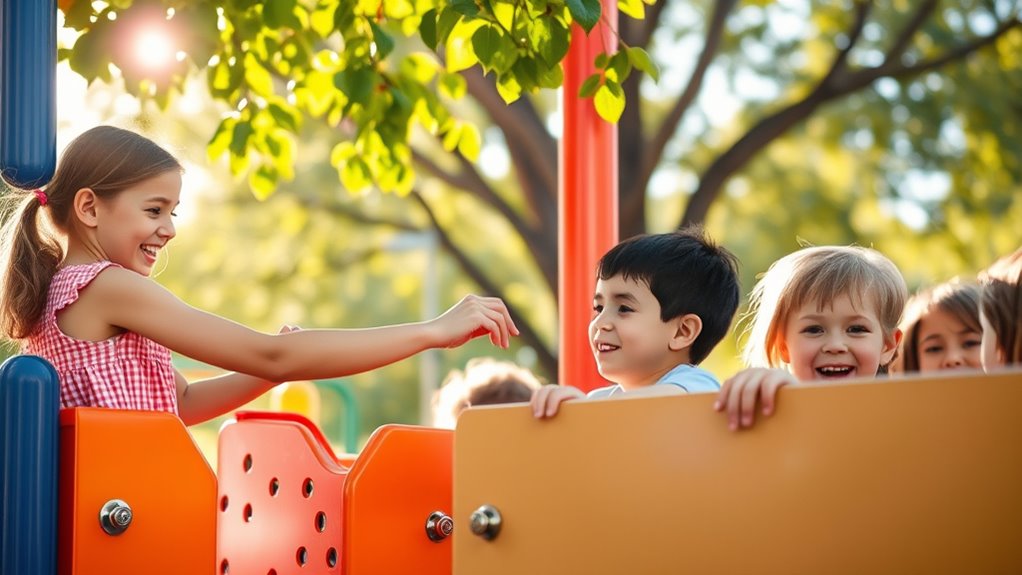
Social-emotional learning (SEL) plays an essential role in shaping how children navigate their emotions and interactions. By developing skills like self-awareness and self-management, you help kids understand their feelings and regulate their behavior.
Social awareness and relationship skills enable them to recognize others’ emotions and build positive connections. Responsible decision-making fosters informed choices, enhancing their overall well-being.
The benefits of SEL are profound; it leads to improved academic performance, reduced behavioral issues, and better mental health. Additionally, SEL cultivates resilience, allowing students to cope with stress and setbacks effectively.
Ultimately, nurturing these social-emotional skills not only prepares children for success in school but also lays the groundwork for thriving in life and future careers.
Strategies for Building Resilience
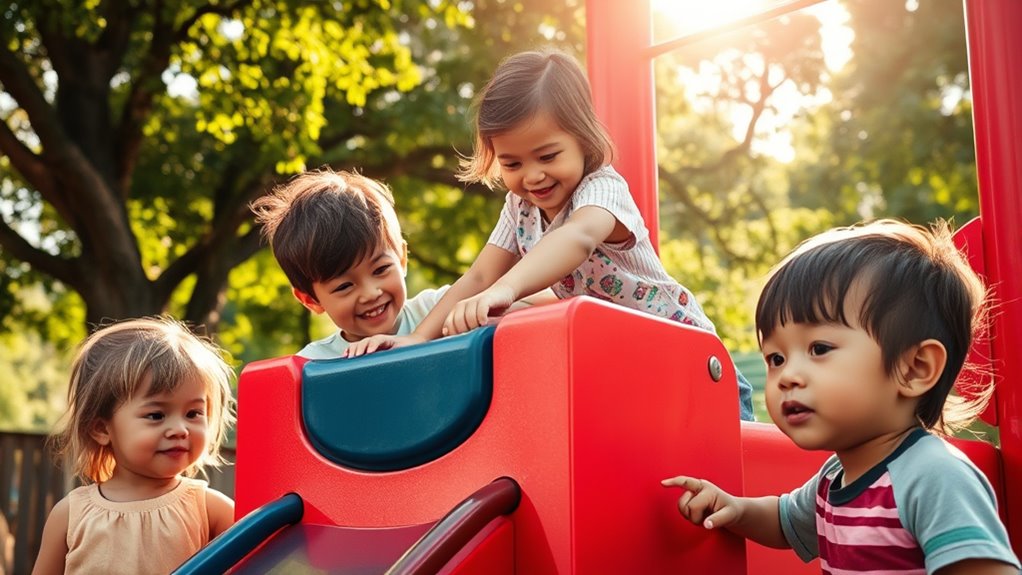
Building resilience is an important aspect of social-emotional development, helping children navigate life’s challenges effectively. To foster this resilience, encourage acceptance and mindfulness by teaching them to observe their emotions without judgment. Understanding the impact of long-term financial planning can also provide a sense of security that contributes to emotional stability. Regular outings for puppy socialization can similarly enhance a child’s adaptability and confidence in social settings. In addition, teaching them about successful co-parenting tips can help them maintain stability during family transitions.
Help them recognize physical signs of stress and engage in mindfulness practices. Cultivating perspective and optimism is essential too; guide them to focus on what they can control and reframe challenges as growth opportunities.
Recognizing stress signals and practicing mindfulness helps children reframe challenges as opportunities for growth and resilience.
Strong social connections matter, so promote nurturing relationships and support-seeking behaviors. Don’t overlook health and self-care—encourage regular exercise, healthy eating, and joyful activities.
Finally, develop problem-solving skills and a sense of purpose to motivate them through adversity, emphasizing their capacity to adapt and contribute positively to their environment. Additionally, consider incorporating strategies from supporting children through divorce to help them cope with significant life changes more effectively.
Social-Emotional Development in Educational Settings

When students feel supported emotionally in educational settings, they’re more likely to thrive academically and socially.
The CASEL Framework emphasizes the importance of integrating social-emotional learning (SEL) within classrooms, schools, families, and communities. By focusing on self-awareness, self-management, social awareness, relationship skills, and responsible decision-making, you can create a well-rounded environment that promotes emotional well-being.
Incorporating classroom-based approaches like cooperative learning enhances these skills. Schools play a vital role by fostering positive relationships and a supportive climate, ensuring every student feels a sense of belonging.
Additionally, involving families strengthens SEL efforts, making it a shared responsibility. Together, these elements not only improve academic performance but also equip students with essential life skills for future success.
Supporting Vulnerable Populations

How can we effectively support vulnerable populations in their social and emotional development?
Start by understanding their unique challenges, such as trauma, health needs, and housing instability. Programs like Early Intervention can be essential in addressing developmental delays and mental health issues.
Create a supportive environment that fosters resilience, helping children adapt to adversity. Recognize that environmental factors, like violence or homelessness, can greatly hinder their growth.
Fostering resilience is crucial; acknowledging and addressing environmental challenges can significantly enhance children’s growth and adaptation.
Engage with families and communities to provide tailored resources, especially for marginalized groups like LGBTQ+ youth who face additional barriers.
Building strong support systems can make a meaningful difference, ensuring vulnerable populations receive the timely interventions they need to thrive emotionally and socially.
Your involvement can help pave the way for better outcomes.
Economic and Health Impacts of Resilience
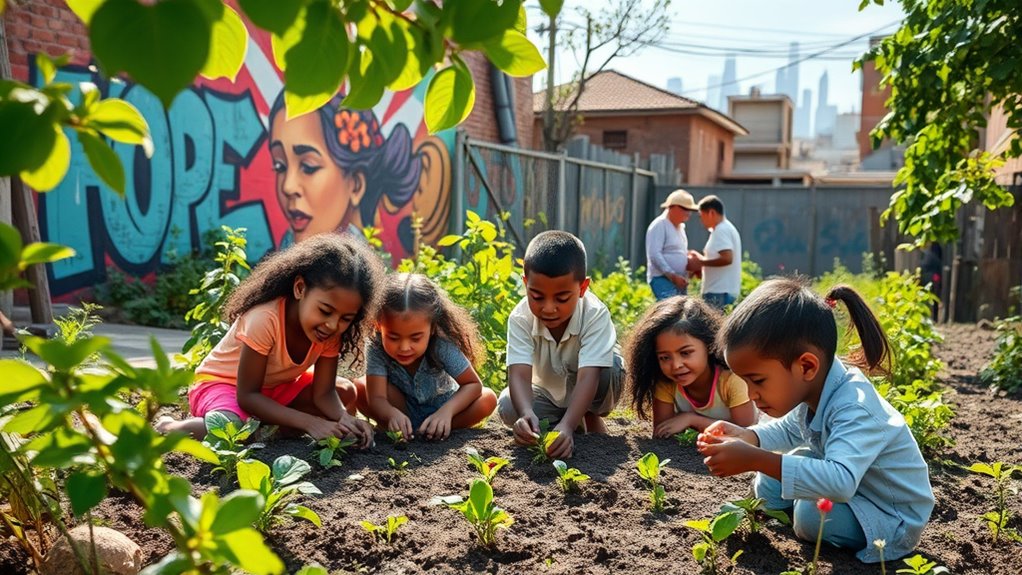
Resilience not only strengthens individuals but also boosts communities economically and health-wise. When you invest in resilience, you can save $6 to $13 for every dollar spent on damage reduction and cleanup. This investment creates jobs, increases workforce participation, and attracts new residents, fueling economic growth. Additionally, by ensuring business continuity, you help maintain operational stability, preventing asset loss and income decline.
Moreover, creating spaces that promote enhanced quality of life not only supports individual resilience but also fosters a sense of community. It is important to recognize that emotional neglect can undermine one’s ability to build resilience in various life contexts. On the health front, building resilience reduces chronic stress and enhances emotional well-being, leading to better overall health outcomes. For instance, studies show that pet therapy can significantly improve emotional well-being among vulnerable populations, contributing to their resilience. Improved social connections and supportive environments further promote resilience, especially in vulnerable populations. Furthermore, fostering emotional regulation is essential for developing resilience, as it helps individuals manage stress and navigate challenges effectively.
Frequently Asked Questions
What Age Is Best to Start Resilience-Building Activities?
You can start resilience-building activities as early as infancy. Engaging in play-based exercises helps children learn patience and adaptability.
As they grow, incorporating activities that promote emotional regulation and social interaction is essential. During middle childhood and adolescence, focus on encouraging autonomy, problem-solving, and emotional awareness.
No matter the age, fostering a supportive environment and providing opportunities for self-reflection will enhance their resilience, making it a lifelong skill.
How Can Parents Support Resilience at Home?
Picture your child as a sturdy tree in a storm, and you’re their anchor. To support resilience at home, create a structured routine that offers security.
Model emotional regulation by expressing feelings openly. Encourage discussions about emotions and practice problem-solving together.
Build strong relationships through family activities and community involvement. By fostering a safe, supportive environment, you help your child develop the skills they need to weather life’s challenges.
Are There Specific Programs for Adolescents?
Yes, there are several specific programs for adolescents that focus on building resilience.
For instance, the Resilient Youth Program and Resilient Teen Programs teach stress management and emotional control.
The Youth Resilience Programme emphasizes community engagement, while the Living in Families with Emotions (LIFE) Program targets stress management for middle schoolers and their caregivers.
Each program aims to equip you with valuable skills to navigate challenges and enhance well-being during these formative years.
How Does Culture Influence Resilience Development?
Think of culture as a sturdy tree, providing branches of support during life’s storms. Your resilience develops through cultural beliefs and practices, shaping how you perceive challenges.
Community cohesion offers a network for help, while spiritual traditions can guide you through tough times. Embracing your cultural identity strengthens your ability to bounce back, and the values shared within your community foster a sense of unity, enhancing your resilience in the face of adversity.
What Role Do Peers Play in Resilience?
Peers play an essential role in your resilience. They provide support, encouragement, and a sense of belonging, which can help you cope with challenges.
When you have positive peer relationships, you’re more likely to develop effective coping skills and feel empowered. Additionally, your peers can influence your social adaptation and self-esteem, making it easier for you to navigate difficult situations.
Ultimately, strong peer connections can greatly enhance your ability to bounce back from adversity.
Conclusion
Building resilience isn’t just for the tough kids; it’s a skill every child can learn, no matter their background. By prioritizing social-emotional development, you’re not only helping children face challenges but also setting them up for future success. Remember, resilience can be nurtured through everyday interactions and intentional practices. So, don’t underestimate your role—your support can make a world of difference in their ability to thrive in life’s ups and downs.




